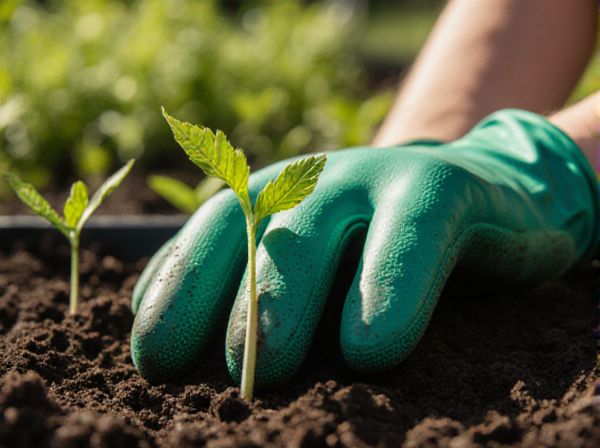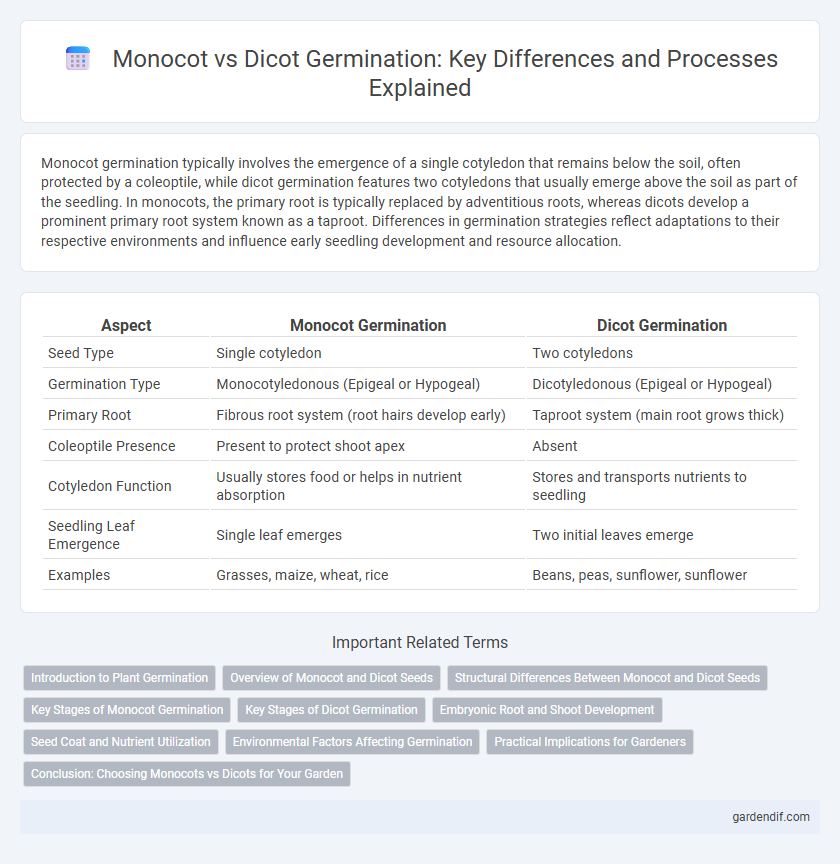
Monocot Germination vs Dicot Germination Illustration
Monocot germination typically involves the emergence of a single cotyledon that remains below the soil, often protected by a coleoptile, while dicot germination features two cotyledons that usually emerge above the soil as part of the seedling. In monocots, the primary root is typically replaced by adventitious roots, whereas dicots develop a prominent primary root system known as a taproot. Differences in germination strategies reflect adaptations to their respective environments and influence early seedling development and resource allocation.
Table of Comparison
| Aspect | Monocot Germination | Dicot Germination |
|---|---|---|
| Seed Type | Single cotyledon | Two cotyledons |
| Germination Type | Monocotyledonous (Epigeal or Hypogeal) | Dicotyledonous (Epigeal or Hypogeal) |
| Primary Root | Fibrous root system (root hairs develop early) | Taproot system (main root grows thick) |
| Coleoptile Presence | Present to protect shoot apex | Absent |
| Cotyledon Function | Usually stores food or helps in nutrient absorption | Stores and transports nutrients to seedling |
| Seedling Leaf Emergence | Single leaf emerges | Two initial leaves emerge |
| Examples | Grasses, maize, wheat, rice | Beans, peas, sunflower, sunflower |
Introduction to Plant Germination
Plant germination initiates with seed imbibition, activating metabolic processes that lead to embryo growth. Monocot germination typically features a coleoptile protecting the emerging shoot, while dicot germination involves the unfolding of two cotyledons that often function in nutrient storage and photosynthesis. Understanding these structural differences highlights key developmental adaptations in seedling establishment across plant groups.
Overview of Monocot and Dicot Seeds
Monocot seeds, such as corn and wheat, contain a single cotyledon that stores nutrients to support germination, while dicot seeds like beans and peas possess two cotyledons that not only store food but also play a role in photosynthesis once germination begins. The seed coat in monocots is typically thinner and remains mostly intact, contrasting with the thicker, often more protective seed coat of dicots that aids in defense against environmental stress. Nutrient mobilization during germination also differs, with monocots relying on endosperm reserves and dicots primarily utilizing cotyledon-stored food for embryo development.
Structural Differences Between Monocot and Dicot Seeds
Monocot seeds contain a single cotyledon that primarily functions in nutrient absorption, while dicot seeds have two cotyledons that often serve as food storage structures. The seed coat in monocots is usually thin and fused with the fruit, contrasting with the thicker, more distinct seed coat found in dicots. Monocot embryos generally exhibit a coleoptile and coleorhiza protecting the shoot and root, features absent in dicots, which develop epicotyl, hypocotyl, and radicle without specialized protective sheaths.
Key Stages of Monocot Germination
Monocot germination begins with water absorption, triggering the activation of enzymes that break down stored starch into sugars for energy. The coleoptile emerges first, protecting the young shoot as it pushes through the soil, followed by the development of primary roots from the radicle. Unlike dicots, monocots lack a distinct hypocotyl and cotyledons; instead, the single cotyledon remains below ground, transferring nutrients to the growing seedling.
Key Stages of Dicot Germination
Dicot germination involves key stages such as imbibition, where the seed absorbs water and swells, followed by enzyme activation that breaks down stored food reserves in the cotyledons. The radicle emerges first, developing into the primary root, while the hypocotyl elongates to push the plumule above the soil surface. Cotyledons often emerge and expand to provide initial photosynthesis before true leaves develop.
Embryonic Root and Shoot Development
Monocot germination features a single embryonic root (radicle) that develops into a fibrous root system, while the embryonic shoot (coleoptile) protects the first leaves as they emerge. In dicot germination, the embryonic root grows into a primary taproot, and the shoot develops a protective structure called the hypocotyl hook, which helps push the cotyledons above ground. These distinct embryonic root and shoot development patterns reflect adaptations to different soil penetration and nutrient absorption strategies.
Seed Coat and Nutrient Utilization
Monocot germination features a single seed coat layer that protects the embryo while allowing gradual water absorption, supporting the endosperm as the primary nutrient source. Dicot germination involves a thicker, often multi-layered seed coat and relies heavily on cotyledons to absorb and distribute stored nutrients from the endosperm for the developing seedling. Both processes optimize nutrient utilization but differ in seed coat structure and storage tissue function, reflecting adaptation strategies for early growth.
Environmental Factors Affecting Germination
Monocot germination typically requires higher moisture levels and warmer temperatures compared to dicots, which can often tolerate a broader range of environmental conditions. Light sensitivity varies, with many monocots being less dependent on light for seed germination, whereas dicots frequently need specific light cues to initiate growth. Soil composition and oxygen availability critically influence both monocot and dicot germination, affecting enzyme activation and energy metabolism essential for seed development.
Practical Implications for Gardeners
Monocot germination, characterized by the emergence of a single cotyledon and a fibrous root system, requires gardeners to provide shallow planting depths and ensure sufficient moisture for rapid seedling establishment. Dicot germination, involving two cotyledons and a prominent taproot, demands deeper planting to support root development and careful soil aeration to prevent damping-off diseases. Understanding these differences enables precise watering, soil preparation, and spacing strategies that enhance seedling survival and growth in diverse garden settings.
Conclusion: Choosing Monocots vs Dicots for Your Garden
Monocots and dicots exhibit distinct germination patterns that influence their suitability for various garden environments. Monocots, such as grasses and lilies, feature a single cotyledon and often show rapid, fibrous root development, making them ideal for ground cover and erosion control. Dicots, including beans and sunflowers, develop two cotyledons and a robust taproot system, providing structural stability and nutrient storage, which benefits diverse garden designs and crop selection.
Monocot Germination vs Dicot Germination Infographic

 gardendif.com
gardendif.com